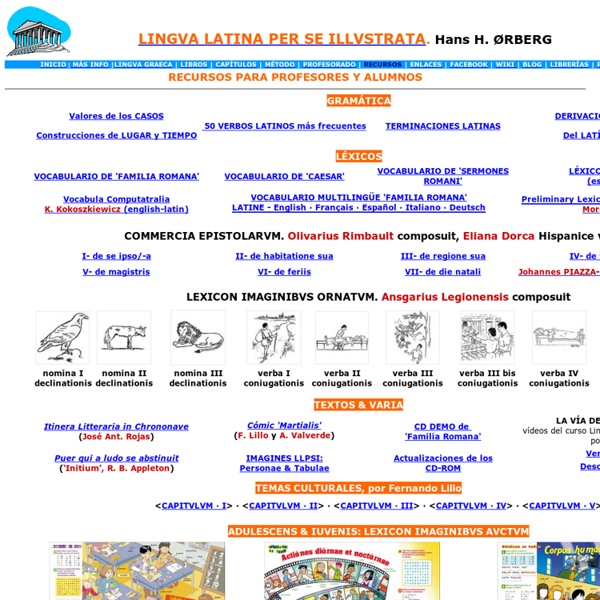



http://www.culturaclasica.com/lingualatina/recursos.htm
Related: LATIN • latinAVE DISCIPULE AVE DISCIPVLE… Ich bin Ihr Computer,willkommen auf meiner Website ! In einigen wenigen Worten, worum es bei diesem Spiel geht : Sie können die fünf lateinische Deklinationen lernen und gleichzeitig Ihren Spaß haben. Sie lernen die fünf Deklinationen Schritt für Schritt kennen : Sie wählen den Schwierigkeitsgrad der Übung und die Zeitspanne, die Sie zur Beantwortung meiner Fragen brauchen. Ich helfe Ihnen dabei. Es handelt sich um ein echtes Spiel mit BONUS-Punkten und MALUS-Punkten und um Punktzahlen, die es zu schlagen gilt ! Weiter !
100 Interesting Facts About Ancient Rome Rome wasn’t built in a day, as the cliché reminds us. Neither did the greatest power of the ancient world fall in one swift cataclysm as some past historians believed. The history of Rome is long and complex: a village grew into the Eternal City that’s still a wonder today; a monarchy became a republic and then an empire; Italy was conquered before Europe, parts of Africa and the Near and Middle East were incorporated into an empire that had around a quarter of the world’s population under its governance. This 1,000-year-and-more history is complex and fascinating, here are just 100 facts that help illuminate it.
CirLaLu - Septimum studium: Temporis expressio ad imprimendum a – Per adverbium QUANDO? Hodie, heri, cras, interdiu, noctu, mane, vespere, nunc,tum, tunc, ibi, mox, brevi, sero, simul, statim, repente, continuo, olim, quondam, pridie, postridie, nuper, modo, antea, postea, interea, primum, ultimum... ANTE + accusativum (e.g. ante imbrem; Accidit ante duos annos) POST + accusativum (e.g. post adventum Alexandri; Veniet post tres dies) IN + accusativum (e.g. in crastinum diem te videbo) INTER + accusativum (e.g. inter ova et mala)
Rome Timeline To navigate the timeline, click and drag it with your mouse, or click on the timeline overview on the bottom. Legend: 753 BCE: The legendary founding date of Rome. 753 BCE - 510 BCE: Regal Period of ancient Rome from Founding to Birth of the Republic. 750 BCE - 510 BCE: The (semi-mythological) seven kings of Rome: Romulus, Numa Pompilius, Tulus Hostilius, Ancus Marcius, Lucius Tarquinius Priscus, Servius Tullius, Lucius Tarquinius Superbus. 750 BCE - 510 BCE: The semi-legendary celeres or trossuli - a 300-man cavalry corps which the first kings of Rome incorporated into the legion - is formed, later their number is increased to 600. BIENVENUE DANS LE MONDE DU LATIN VIVANT Vous pouvez aussi consulter sur ce thème les articles suivants rédigés en différentes langues: Et maintenant, voici quelques exemples de latin parlé (ou de latin moderne): Les nouvelles en latin de la radio finlandaise donnent un bon exemple de latin moderne.
The Facts Behind the Curse of Tutankhamun: Fake News from Beyond the Grave The last great discovery of the golden age of Egyptology – and the first in a new age of mass media – the unearthing of the tomb of the boy king was a sensation, talked about in the popular press and captured on flickering newsreels. The inner chamber was breached by archaeologist Howard Carter on 16 February 1923 and by April, Carter’s outlandish financier George Herbert, 5th Earl of Carnarvon (often referred to as ‘Lord Carnarvon’) was dead. The cause was gruesome and Carnarvon sliced open an infected mosquito bite while shaving, leading to blood poisoning and pneumonia. It’s tempting to trace the ‘curse’ back to Daily Mail correspondent Arthur Weigall, who lashed out at Carnarvon giving exclusive access to the rival Times. A passionate (if controversial) Egyptologist who did much to popularise the subject back in Britain, Weigall was no friend to superstition but for lack of anything else to report he tried to have his cake and eat it.
Latin pour débutants Forum L’inscription à cette formation est facultative, mais elle vous permet de participer au forum pour interagir entre apprenants et avec votre professeur ! Inscrivez-vous facilement et gratuitement en vous enregistrant en page d’accueil de ce forum (lien “M’enregistrer”). Les données collectées lors de cet enregistrement (identité, situation, motivations) ne servent que nos statistiques, elles sont protégées conformément à la loi informatique et libertés (déclaration CNIL n°1802319 v 1) et au RGPD (règlement général sur la protection des données). Ouverture Cronologia de la Historia de Roma Principales Hitos Cronologica Inicio » Historia Antigua » Cronologia de la Historia de Roma Principales Hitos Cronologica Según la leyenda, Rómulo fue el primero en ocupar el trono de Roma. Quienes invocaban ser sus descendientes heredaron el trono y se convirtieron en ciudadanos, a partir de una legitimidad que se basaba en razones de estricto linaje: ser miembros del patriciado.
Latin oral, premier cours de l'année : faisons connaissance Latin - Première séance : Politesse élémentaire. I – L’accueil : Salve : Bonjour (à un/e) Salvus sis : Bonjour (à un garçon) Salva sis : Bonjour (à une fille) Salvi sitis : Bonjour (à plusieurs)
Anexo:Cronología de la Antigua Roma Luperca amamantando a los gemelos Rómulo y Remo, fundación de Roma. La siguiente cronología de la Antigua Roma refiere los hechos más importantes de la antigua civilización romana desde la fundación de la ciudad hasta la caída del Imperio romano de Occidente. Cuanto más antiguas son las fechas, más probable es que se trate de aproximaciones inexactas o hechos meramente legendarios. Monarquía (753-509 a.